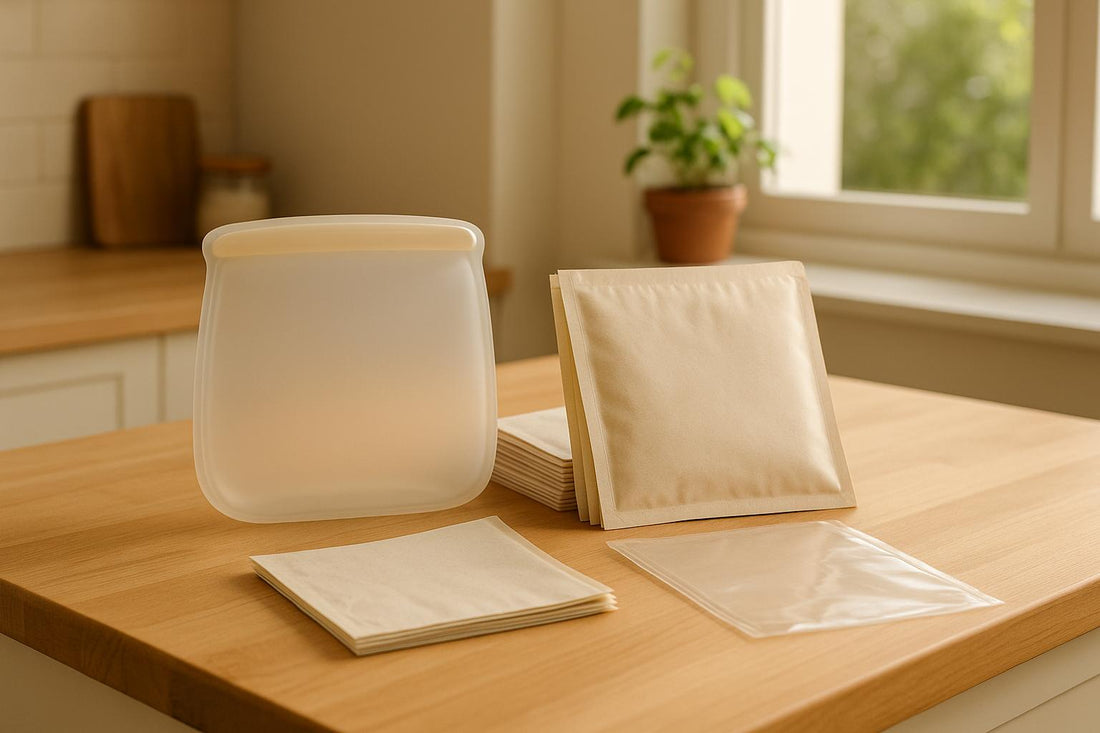
Sous Vide Packaging: Eco-Friendly Options
Share
Sous vide cooking is precise and convenient, but the reliance on single-use plastics raises concerns about waste and pollution. If you're looking for greener solutions, here are three options to consider:
- Reusable Silicone Bags: Long-lasting, heat-resistant, and a waste-reducing alternative to disposable plastics. Though pricier upfront, they save money over time.
- Compostable Vacuum Bags: Made from plant-based materials, these single-use bags decompose in industrial composting facilities. However, they require proper disposal infrastructure and cost more than traditional options.
- Bioplastic Films: Crafted from renewable sources like corn or algae, they handle sous vide temperatures well and have a lower production footprint. They remain costly and depend on specific composting methods.
Each option has trade-offs in cost, durability, and disposal requirements. Your choice should align with your cooking habits and access to composting facilities.
Eco-Friendly Sous Vide Cooking: 100% Pure Platinum Silicone Bags
1. Reusable Silicone Sous Vide Bags
Reusable silicone bags are a sturdy and eco-friendly option for sous vide cooking, offering a practical alternative to single-use plastic bags. Made from food-grade silicone, these bags handle the precise temperatures required for sous vide while cutting down on waste.
Durability and Heat Resistance
Silicone bags are built to handle extreme heat, withstanding temperatures up to 428°F (220°C) - a sharp contrast to conventional plastic bags, which start to melt at around 212°F (100°C). Their strong, tear-resistant design ensures a reliable, leak-proof seal, even after repeated use. Plus, these bags are freezer-safe, making them perfect for both storing and transporting food.
| Feature | Silicone Bags | Plastic Bags |
|---|---|---|
| Heat Resistance | Up to 428°F (220°C) | Around 212°F (100°C) |
| Lifespan | Designed for years of use | Single-use only |
| Airtight Seal | Yes (in most designs) | No |
| Durability | Tear-resistant and robust | Prone to tearing |
This level of performance not only ensures consistent cooking results but also promotes a more sustainable approach to food preparation.
Environmental Impact
The reusability of silicone bags is a major win for the environment. A single silicone bag can replace countless disposable plastic bags over time, significantly reducing packaging waste and its impact on the planet.
Cost and Availability
Although silicone bags generally cost more upfront compared to disposable options, their durability can lead to substantial savings in the long run. When purchasing, make sure to choose BPA-free, food-grade silicone bags to ensure safe food handling.
2. Compostable Vacuum Bags
Compostable vacuum bags are a single-use packaging solution crafted to decompose under proper composting conditions. Made from plant-based biodegradable polymers, they offer an environmentally conscious alternative to traditional plastics, appealing to those seeking a more sustainable option.
Durability and Heat Resistance
The performance of these bags in sous vide cooking depends on their specific design and material composition. They typically handle moderate sous vide temperatures well but may face challenges with seal integrity during longer cooking times or at higher temperatures. This variability means users should carefully select products suited to their cooking needs.
Environmental Impact
In industrial composting facilities, these bags break down much faster than conventional plastics. However, they require specific conditions to decompose effectively, so it's crucial to check if local waste management services can handle them. Without access to appropriate composting infrastructure, their environmental benefits may not be fully realized.
Cost and Availability
Compostable vacuum bags tend to be more expensive than standard plastic options, as their materials are sustainably sourced. Their higher price reflects the effort to reduce plastic waste. As interest in sustainable packaging grows, these bags are becoming more widely available. Still, before making the switch, users should confirm that proper composting facilities are accessible in their area. Up next, we’ll explore bioplastic films as another sustainable alternative.
sbb-itb-c693c43
3. Bioplastic Films and New Materials
Building on the discussion of compostable options, bioplastic films present another environmentally conscious choice for sous vide packaging. These films are crafted from renewable, plant-based materials like corn starch, sugarcane, and potato starch, offering a greener alternative to the petroleum-based plastics traditionally used in sous vide cooking.
Recent developments have led to bioplastic films specifically designed for sous vide applications. For instance, polylactic acid (PLA) films are engineered to handle moderate cooking temperatures, making them a solid choice for items like vegetables, fish, and delicate proteins. On the other hand, polyhydroxyalkanoate (PHA) films, derived from microorganisms, provide better barrier properties and can withstand higher temperatures. Some hybrid films combine plant-based polymers with additives like chitosan to improve heat resistance and maintain structural integrity during cooking. Let’s dive deeper into how these films perform in practice.
Durability and Heat Resistance
One of the key advancements in bioplastic films is their improved ability to tolerate heat. PLA-based films are well-suited for recipes requiring moderate temperatures, while PHA-based options offer greater durability for higher-temperature cooking. However, it’s essential to choose the right type of film based on your specific sous vide needs, as different formulations react differently to prolonged exposure to heat and moisture.
Environmental Impact
Bioplastic films are a step forward in reducing the environmental impact of sous vide packaging. Their production typically generates fewer greenhouse gas emissions compared to traditional plastics. Like compostable bags, these films perform best in industrial composting settings, where they break down more effectively. However, their overall sustainability depends on the source of the raw materials. For example, PLA made from corn may compete with food resources, while algae-based alternatives could sidestep this issue. When combined with proper disposal methods, these films can significantly reduce waste in sous vide cooking.
Cost and Availability
Currently, bioplastic films are more expensive than conventional plastic bags due to the high cost of raw materials, specialized production techniques, and limited manufacturing scale. These eco-friendly options are often sold through specialty suppliers or directly from manufacturers. As production scales up, prices may become more competitive, making them more accessible to home cooks. To maximize their environmental benefits, ensure access to local composting facilities capable of processing these materials.
Pros and Cons
Eco-friendly sous vide packaging options come with their own set of benefits and challenges, influencing both performance and sustainability. Choosing the right material depends on your cooking habits, budget, and environmental goals. Here's a closer look at the pros and cons of popular options:
| Packaging Type | Pros | Cons |
|---|---|---|
| Reusable Silicone Bags | • Can withstand high temperatures • Long-lasting with proper care • Reduces single-use waste • Cost-effective over time • Easy to clean and maintain |
• Higher initial cost • Limited size options • Requires thorough cleaning after use • May absorb strong food odors • Needs extra storage space |
| Compostable Vacuum Bags | • Breaks down in industrial composting facilities • Functions like traditional plastic bags • Reduces long-term environmental impact • Works with standard vacuum sealers • No cleaning required |
• More expensive than regular vacuum bags • Needs access to proper composting facilities • Shorter shelf life due to natural materials • May not be widely available |
| Bioplastic Films | • Made from renewable plant-based materials • Lower carbon emissions during production • Handles moderate to high temperatures • Biodegradable under specific conditions • Constantly improving formulations |
• Often the priciest option • Limited durability for extended high-temperature use • Requires specialized disposal methods • Can be harder to source • Supplier networks are still developing |
When weighing these factors - cost, longevity, and environmental impact - it’s clear that each option has unique strengths and trade-offs.
Silicone bags, while more expensive upfront, can save money in the long run due to their durability. Compostable and bioplastic alternatives, on the other hand, come with recurring costs but provide a clear environmental advantage.
Convenience also varies. Compostable bags function similarly to traditional vacuum bags, with disposal being the primary difference. Silicone bags require more effort for cleaning and storage but offer a long lifespan. Bioplastic films, while eco-friendly, may need specific disposal processes due to current supply chain limitations.
Ultimately, the best choice depends on how you balance heat resistance, ease of use, and durability with your cooking habits and sustainability goals.
Conclusion
Eco-conscious sous vide packaging now blends sustainability with precision cooking. Here's a quick look at the standout features of these greener alternatives:
- Reusable silicone bags: Known for their durability and heat resistance, they are perfect for repeated use.
- Compostable bags: A single-use option that can break down in compost, provided you have access to suitable composting facilities.
- Bioplastic films: Made from renewable materials, these are designed to handle controlled heat exposure while minimizing emissions during production.
Your choice should align with your cooking habits and the facilities available in your area. These options show that sustainable sous vide cooking is not only possible but also practical. By making the switch, you can reduce waste and bring a touch of environmental responsibility to your kitchen.
FAQs
What are the environmental advantages of using reusable silicone bags for sous vide cooking instead of single-use plastic bags?
Reusable silicone bags offer a greener option for sous vide cooking compared to single-use plastic bags. They’re long-lasting, simple to clean, and built for repeated use, helping to cut down on the mountain of plastic waste generated by disposable alternatives. By swapping out single-use bags for silicone ones, you’re taking a meaningful step toward reducing the environmental toll of plastic consumption.
What’s more, silicone bags boast a smaller environmental footprint throughout their lifecycle. Unlike typical plastic bags, they don’t contain harmful plastics and can be reused thousands of times. This makes them a smart and sustainable choice for anyone, from home cooks to professional chefs. Choosing reusable silicone bags is an easy and impactful way to cook with less waste and contribute to a cleaner planet.
How can I find out if my local composting facility accepts compostable vacuum bags?
Composting facilities across the U.S. have different rules when it comes to handling compostable vacuum bags. Many will accept bags that meet the certification standards of ASTM D6400 or D6868, but it's always a good idea to double-check. Reach out to your local waste management or composting facility to confirm they can process these materials correctly.
Can bioplastic films be used for all sous vide recipes, and how do I select the right one for different cooking temperatures?
Bioplastic films aren’t the best fit for every sous vide recipe, especially those that call for higher cooking temperatures. Some types of bioplastics can degrade or even release harmful substances when exposed to excessive heat.
If you’re considering bioplastic films for sous vide, focus on materials like high-density polyethylene (HDPE), low-density polyethylene (LDPE), or polypropylene (PP). These are generally regarded as safer options for food applications and are capable of withstanding typical sous vide temperatures, which usually range from 120°F to 175°F. Always double-check the film’s temperature rating to make sure it’s both safe and suitable for your specific recipe.
